THE EMERGENCE OF THE ROMANIAN PROFESSIONAL CLASS (3 – part I) – TULCEA: 1880 – 1930

Reverend Zenovie Livovschi (right) and his Family at Tulcea, 1884: his wife - Polixenia Nicodinescu (left), his mother-in-law Zinca Eiser (centre left), his father-in-law Constantin Nicodinescu (centre right), his eldest son Vicentiu Livovschi, aged five (left) and daughter Ecaterina Livovschi (aged three, seated right)
 TULCEA is a Romanian port on the right bank of the lower Danube river, close to the Danube Delta and the Black Sea. It came into its own in 1878, after the Treaty of Berlin which followed Romania’s War of Independence from Turkey. As a result of this treaty Romania regained from the Ottomans the province of Dobrogea, whilst Russia its ally profited from the defeat of the Ottoman empire by occupying Southern Bessarabia, hitherto part of the Principality of Moldavia: it gave Russia control of the mouths of the Danube and a say in the Danube Commission. These latest political border changes resulted in huge exchanges of population, whereby Moldavians from these lost three counties of Cahul, Ismail and Balgrad were displaced to colonise instead Dobrogea, together with ethnic Aromanians, who were a Romanian-speaking ethnic group from the Balkan Penninsula South of the Danube.
TULCEA is a Romanian port on the right bank of the lower Danube river, close to the Danube Delta and the Black Sea. It came into its own in 1878, after the Treaty of Berlin which followed Romania’s War of Independence from Turkey. As a result of this treaty Romania regained from the Ottomans the province of Dobrogea, whilst Russia its ally profited from the defeat of the Ottoman empire by occupying Southern Bessarabia, hitherto part of the Principality of Moldavia: it gave Russia control of the mouths of the Danube and a say in the Danube Commission. These latest political border changes resulted in huge exchanges of population, whereby Moldavians from these lost three counties of Cahul, Ismail and Balgrad were displaced to colonise instead Dobrogea, together with ethnic Aromanians, who were a Romanian-speaking ethnic group from the Balkan Penninsula South of the Danube.
The Livovschi family was part of this same equation: they left their village of Hadjiabdullah in County Cahul where 22-years old Reverend Zenovie was the Orthodox parish priest
to become Deacon of St Nicholas Cathedral in Tulcea. For the young Romanian priest this was a God-sent promotion signed by the diploma of Joseph, Archbishop of the Lower Danube at Galatz on 17 April 1880 (nr 266 countersigned by Arhimandritul Ciuca):
“By the Grace of God, the Most Humble Joseph, Archbishop of Lower Danube”
(Prin mila lui Dumnedeu, prea-Smeritul Iosif, Arhiepiscopul Dunarei de Jos)
Reverend Zenovie’s first challenge was to consolidate the Romanian Orthodox church in the new province as the old-established Greek and Bulgarian Orthodox hierarchs were jostling with each other to preserve their influence and status in the province, in spite of the new order established by the national Romanian Orthodox church.
At the same time, young Reverend Zenovie was also to be nominated to the chair of religious education at Tulcea Spiru Haret College which he served for the next two decades. This is confirmed in a letter nr 52617 dated 18 Sep 1878 from the “Ministerul Cultelor si al Instructiunei Publice” Bucuresti addressed to Rev Zenovie as:
“Cucernice Parinte, Subsemnatul am onoarea de a va face cunoscut, ca va numesc pe diua presentarii la post profesor suplinitor la catedra de religiune de la liceul din Tulcea” (signed by the Minister and Director respectively)
Rev Zenovie’s endeavors did not pass unnoticed in April 1913 he is promoted By Nifon, archbishop of the Lower Danube (Galati) to the grade of “Stavrofor” (priest allowed to wear the pectoral cross during the Holly Service) and on the 1914, 5 February he is further nominated to serve as President of the Theological Tribunal in the new territory of Balcic (Southern Dobrogea, acquired from Bulgaria as the result of the First Balkan war 1912-1913).
FAMILY BEGINNINGS: Reverend Zenovie’s direct ancestors were all Romanian Orthodox priests going back to Reverend Ioan of Sudarca, County Soroca (Popa din Sudarca) who built the wooden church of Archangel Michael in 1793: this church is preserved to this day as a national monument in the Open-air Museum in Chisinau, of what is now the Republic of Moldova.
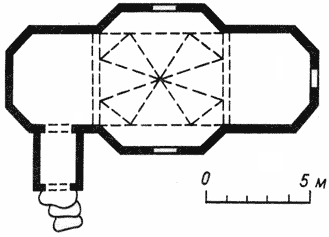
Plan of the wooden church of Sudarca, Co Hotin, erected in 1793 by Rev Ioan Livovschi (Popa din Sudarca), gt gt grandfather of Rev. Zenovie Livovschi of Tulcea
The Reverend Ioan fled the Uniate religious persecution waged against Romanian Orthodox believers from Galicia, a Polish province which was occupied by the Habsburgs during the 18th century partition of Poland. As they fled the city of Lwow, capital of Galicia, to seek refuge in Northeastern Moldavia, then occupied by the Russian Czar, during the first Russian census of Bessarabia the family were nicknamed after the city of Lwow, where they came from, being given the surname of Livovschi. Theirs was a large clan with several cousins graduating form theological schools to climb the slippery ladder of the Orthodox church hierarchy in Russia: one of these cousins was a composer of liturgical music and choir master at the Czar’s cathedral in St Petersburg:
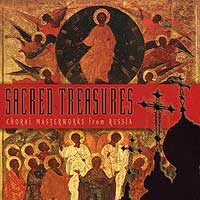
Russian Lithurgical Music by Grigory Lvovsky - Choir master at the Czar's cathedral in St Petersburg
This was Grigory Lvovski whose Cherubic Hymn is sung today in all Orthodox churches around the world. Another kinsman was during the 19th century the founder of the Russian Orthodox Mission in Japan and another cousin became the abbot of one of the main monasteries of Bessarabia. The Czarist administration of Bessarabia established a rigid social structure on the indigenous Romanian population, along three main classes – aristocrats, clergy and freeholding farmers – the latter having received attractive privileges to induce them settling in a province whose population was dispersed by the ravages of centuries-old wars between the Ottomans and the Russians.
It is therefore clear that in the Russian empire, the Clergy had the elevated status of an educated middle class enjoying certain freedoms and privileges. including the use of a property and farming of the glebe land, not to mention the collection of a church tax from the parishioners. As such the Livovschi prelates were beneficiaries of all these rights. As the Czars extended their empire closer and closer to the Black Sea and the mouths of the Danube, so did Russian-occupied Bessarabia’s borders grow at the expense of the Ottoman empire. With each expansion of the political borders the Livovschis moved South to serve the church in the newly-populated areas. One last such Southward migration during the second quarter of the 19th century was when Reverend Theodore Livovschi, Zenovie’s father moved from County Soroca to TOMAI an area which was the object of an exchange of population whereby the Muslim Tartars were evacuated to the `ottoman provinces of Crimea and their land was resettled by Christian Turks known as Gagauz who originated form Bulgaria, South of the Danube. Reverend Theodore, grandson of Rev. Ioan, the first settler, died young leaving Zenovie as a young orphan who was taken care of by his elder sister Ana. This Ana Livovschi married Rev Ion Stanescu, parish priest in Hadji-Abdullah, County Cahul on the estate of the Prince Constatin Muruzi (1815-1878) Prime Minister of Moldavia who was married to Princess Raluca Mavrocordat. Ana Livovschi Stanescu ensured that her younger brother Zenovie enrolled in the Theological Orthodox Seminary of Ismail (Scoala Duhovniceasca) to follow the family’s ancient tradition of clerics. As the Orthodox church required priests to be married before they were ordained, Zenovie found a wife in the village where his brother-in-law was parish priest. This was Polixenia Nicodinescu daughter of Constantin Nicodinescu and Zinca Eiser, both refugees from the 1848 Revolution, who fled the city of Fagaras in Transylvania to settle on Moruzi’s estate in Co Cahul. Here Constantin, who was an iron master was employed as miller in the village of Hadji Abdullah.
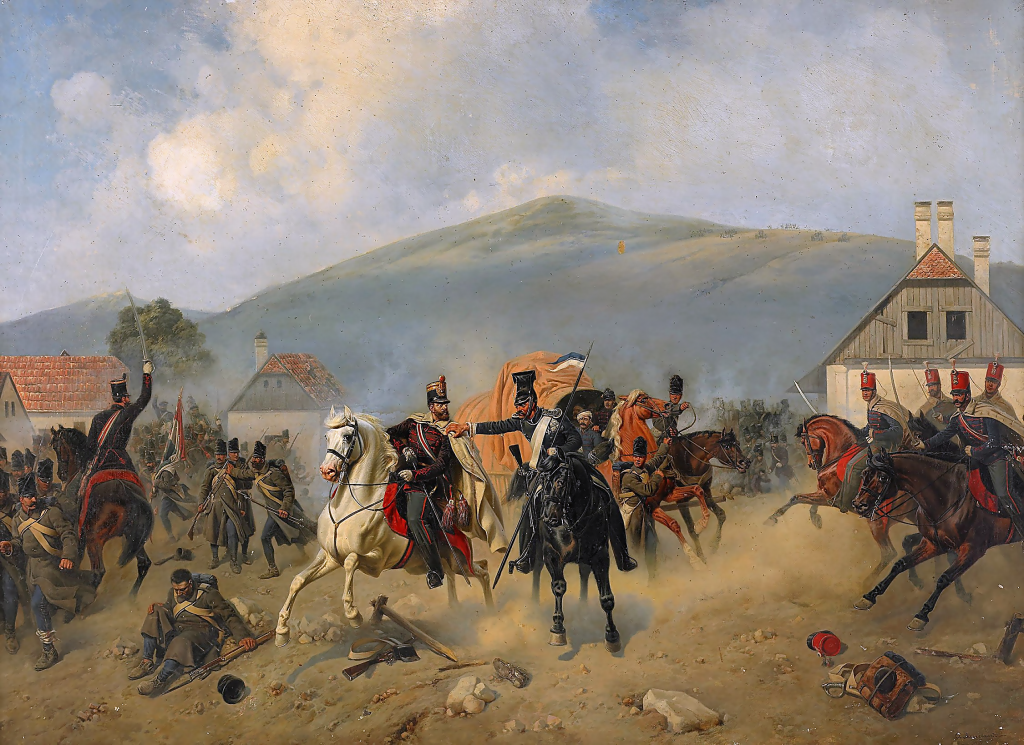
Transylvania - 1848 Revolution which caused Ironmaster Constantin Nicodinescu of Fagaras to take refuge in Moldavia
To this couple of refugees a baby daughter was born, whose godmother was the landlowner’s wife Princess Raluca Mavrocordat. Being the daughter of a Phanariot ruling prince, Raluca Mavrocordat Moruzi chose for her god daughter a Greek christian name of Polixenia. At the age of sixteen Polixenia was to marry Reverend Zenovie in Hadjiabdullah where their first son Vicentiu was born n 1889. This was only a year after the Treaty of Berlin by which the Kingdom of Romania gained its independence. By 1880 the young Livovschi family migrated South to the new Romanian province of Dobrogea where they took with them the elderly Nicodinescu parents – all of them seen in the above photograph, taken in 1884 in Tulcea.
Livovschi between 1880 and 1916 at Tulcea:
Rev. Zenovie Livovschi and Polixenia were to have four sons and two daughters: apart from the eldest son Vicentiu, all children were born in Tulcea and all of them were educated at the local Spiru Haret College, which is now an Academy. They lived at the rectory of the St Nicholas cathedral and by the time the two daughters Ecaterina and Emilia became of school age Spiru Haret came also to accept girl pupils. However, the beginnings of the education system in Romania of the 1880s was confronted with certain financial difficulties causing the Ministry of Education being unable to meet its obligation of paying the school wages: st this critical moment Zenovie was the only member of the staff to carry on working without pay as a RE teacher. Amongst his colleagues was Moisil the father of the Mathematician who was going to become an Academician and who remained a family friend.
Family life continued in a very happy environment and to the credit of Zenovie, he succeeded in being able to keep in higher education all his children who went to become graduates from the University of Bucharest:
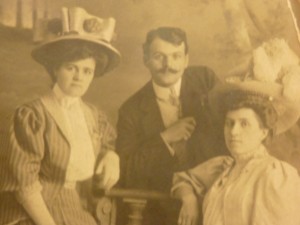
Ecaterina Livovschi Panea - photo taken after her graduation in Medicine from the University of Bucharest. Seen here in 1904 (left) with her brother Vicentiu and sister-in-law (seated) Stefania Burada
the eldest son Vicentiu graduated in Pharmacy. `his sister Ecaterina attended a private school in Bucharest, the Pensionul Pompilian where she befriended Stefania Burada who was going to become Vicentiu’s wife. Ecaterina took a degree in Medicine to become an ophtalmologist and married a fellow doctor Ion Panea. They both started their medical career in Focasni, in Moldavia, before WWI. Emilia, the second daughter also read Pharmacy and married a fellow pharmacist Barozzi who had his pharmacy on Calea Calarasi in Bucharest. As for the younger sons, Virgil Livovschi and Octavian Livovschi, they both studied engineering, one graduating from the University of Grenoble where he was a contemporary of a cousin on his maternal side George Savuleanu. One of them died during the Great War whilst fighting the Germans in the Carpathians at Caineni Pass whilst the other never recovered from shell shock being interned at the Hospital in Cosciugeni, in Bessarabia, where he died soon after.
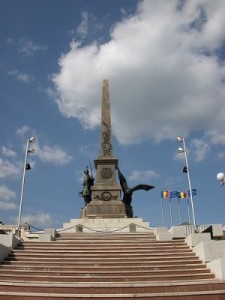
Tulcea: The Monument to the War of Independence of 1877. Vicentiu Livovschi was Captain of the Tulcea Regiment nr 33 Dorobanti and was mentioned in dispatches both during the Second Balkan War as well as the Great War of 1916-1919.
The eldest brother Vicentiu did his military service at Calarasi with the local Tulcea Regiment the 33 Dorobanti. There was a fourth son Aurelian, the youngest and coming as a surprise to the old couple – Rica as he was known, was less academically inclined but a great sportsman/ His education unfortunately was interrupted by the Great War as he had, together with his parents to take refuge in the Danube Delta in the wake of the Bulgarian occupation. Rica established an unusual record on skating on the frozen Danube during winter with the aid of an umbrella which he used as a sail covering the distance between Tulcea and Sulina on the Black Sea in record time. Unfortunately never anyone before or after repeated this feat which was not officially recorded.
Romania entered the Great War on the side of the Allies only after the demise of King Carol I in 1916. By this time all but one of Reverend Zenovie’s children was at home, the youngest son Aurelian (Rica) which was still in secondary education in Tulcea. By this time all his siblings fled the parental nest living either in Bucharest, Buzau or Focsani. The rumblings of the war started to be heard in Tulcea as Romania was occupied by the German armies with the exception of the province of Dobrogea where the Bulgarian armies were out to seek revenge from their defeat in the Second Balkan war, which caused them to lose Balcik with two counties known as the “Cadrilater”. The Bulgarian occupied Tulcea where they made a beeline for the Deanery of St Nicholas cathedral, hoping to extract by hook or by crook all the gold cache which orthodox priests were reputed to have secreted away as savings: no little was their disappointment when Reverend Zenovie told them that he had none: whatever savings he had it went paying the huge university expenses of five of his six children – the Bulgarians would not believe him so they took candles from the cathedral to burn the toes of the old prelate with candle wax, but still to no avail, so they left empty-handed trying their luck elsewhere. The parishioners were horrified knowing Zenovie as a much loved and saintly person, leading a sober life devoted to the church and its community. Amongst them there were some native Tulceans of Bulgarian extraction who took it upon themselves to warn Rev Zenovie that they heard to troops would come back to have a second go at extracting money out of him: they urged Zenovie and his family to flee Tulcea, which he did, hiding with his wife and youngest son Rica in the wilds of the Danube Delta, until the war was over in 1918 and the occupying German and Bulgarian armies repelled.
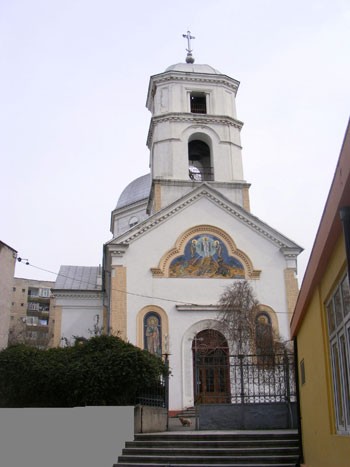
Tulcea - the Church of the Transfiguration (Schimbarea la Fatza) where Reverend Preot Econom Stavrofor Zenovie Livovschi was Rector from 1918 to his retirement in 1930
During the family’s absence the Deanery was destroyed. Now the Reverend Zenovie was given by the Bishop a new, less demanding assignment, as rector of the Church of the Transfiguration (Biserica Schimbarea la Fata), the most ancient church in Tulcea, known as the Russian Church. It stood on the top of one of the seven hills in Tulcea, not far from the Independence Obelisk memorial to the War of Independence, which earlier during the occupation was destroyed by the Bulgars. A new and last chapter was going to unravel for the Livovschi’s presence in the city of Tulcea from 1918 to 1930 when, after 50 years of service to the Orthodox church in town Zenovie and Polixenia retired to a modest retirement house in Bucharest bought for them by their Pharmacist daughter Emilia Barozzi.
Livovschi in TULCEA between 1918 and 1930:
see follow up article
THE EMERGENCE OF THE ROMANIAN PROFESSIONAL CLASS (3 – part II) – TULCEA: 1918 – 1930

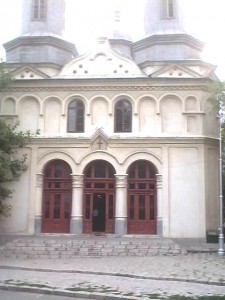


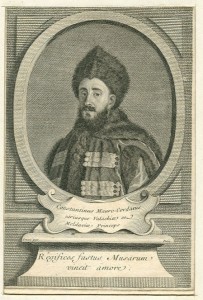

No Comments so far ↓
Like gas stations in rural Texas after 10 pm, comments are closed.